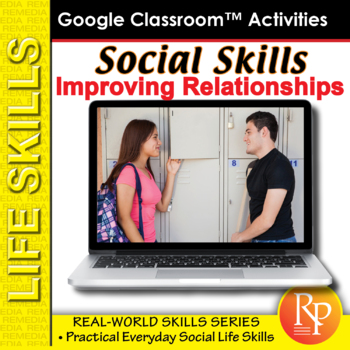Social & Emotional Skills- Improving Relationships: Reading (SEL) GOOGLE SLIDES
- PDF
- Google Apps™
- Internet Activities

What educators are saying
Also included in
- 1,400 GOOGLE SLIDES! | BIG BUNDLE = BIG SAVINGS! | IMPROVING BEHAVIOR | SOCIAL SKILLS | HANDLING MONEY | BANKING | YOUR FIRST JOB | BEING SAFE | SOCIAL MEDIA | PRIVACY | DRIVING A CAR | HEALTH | GETTING ALONG WITH OTHERS. Prepare students for the real-world with this essential liPrice $69.99Original Price $79.92Save $9.93
- Is listening better than talking? Is nonverbal behavior important? Social Skills Lessons to Improve Everyday Relationships! Real-life scenarios and sticky social situations challenge students to learn about themselves and their behaviors such as: losing their temper, bullying, feeling awkwardPrice $14.95Original Price $19.98Save $5.03
Description
Is listening better than talking?
Is nonverbal behavior important?
Social Skills Lessons to Improve Everyday Relationships!
Real-life scenarios and sticky social situations challenge students to learn about themselves and the consequences of behaviors such as: losing their temper, bullying, feeling awkward around others, not making eye contact, talking too much, and more. They also learn the value of being a good friend, first impressions, apologizing, compromising, and tone of voice. Teens and ‘Experts’ offer helpful advice through text messages and keep things light-hearted and non-threatening. A great way to improve students’ everyday social skills!
STANDARDS-BASED READING & WRITING ACTIVITIES:
• Locate Information
• Summarize
• Generalize
• Compare & Contrast
• Cause & Effect
• Form Opinions
• Draw Conclusions
• Main Idea
• Make Inferences
• Use Context Clues
• Sequence
• Determine Author’s Viewpoint
• Analyze, Evaluate & Apply
Topics include:
• How can I make friends and be a good friend?
• What should I do if I have a crush?
• How can I be a better listener?
• What should I do about losing my temper?
• Why should I be the one who apologizes?
• How can I make a good impression on others?
• Why is it good to ask for help?
• How can I get over feeling awkward with others?
Reading Level: Grades 3-4
Interest Level: Grades 6-12
Easy-to-Use:
Simply download these Google Slides and assign them to your students. Assign them all, or just a few for today's lesson! For additional flexibility, these slides can also be printed for in-class use!
Benefits of Google Slides:
If you've been looking for a way to integrate technology into your lessons, this is your answer. And the best part is you don't have to print, cut, laminate, or replace when you lose pieces....it's ALL DIGITAL!
How do Google Slides Work?
Students read each high-interest story on a computer or iPad then answer the comprehension questions right on their copy of the slides. Teachers can see students' answers in real time, or review them later. Slides can also be printed and used as colorful classroom worksheets. You can assign a set of slides to each student, so that they have their own personal packet.







